Dear reader: This article contains links to products and services that I may be compensated for, at no extra cost to you.
I’ll be covering a lot in this article, including varieties of Taiwanese tea, how to order tea from Taiwan, where to buy tea in Taipei and Taiwan, Taipei tea houses, how to brew Taiwanese tea, tea tours in Taipei, and tea-related attractions around Taiwan. Get a pencil and notepad ready!
I’ve been living in Taiwan for over ten years, and I’ve fallen in love with all kinds of Taiwanese foods and drinks, but it wasn’t until a few years ago that I first developed a true appreciation for Taiwanese tea, especially Taiwan’s oolong and black teas for which the country has developed an international reputation.
I’m not talking about pearl milk tea (珍珠奶茶), which of course was invented in Taiwan, nor do I mean the sickly sweet iced tea concoctions sold from Taipei tea shops at every corner (which mostly use cheap imported teas). I mean real Taiwanese tea.
If you’re planning a trip to Taiwan and need travel advice, I’ve got a huge amount of Taiwan content on this site. Start with my 50 favorite places in Taiwan and my 50 favorite places in Taipei! If you’re just here for tea info, then read on!
Here’s a discount code for my favorite Taiwanese tea provider, Eco-Cha: if you click this link then select any teas, a 10% discount will be applied at check-out. Eco-Cha supports small-scale farms using sustainable methods and can mail internationally.
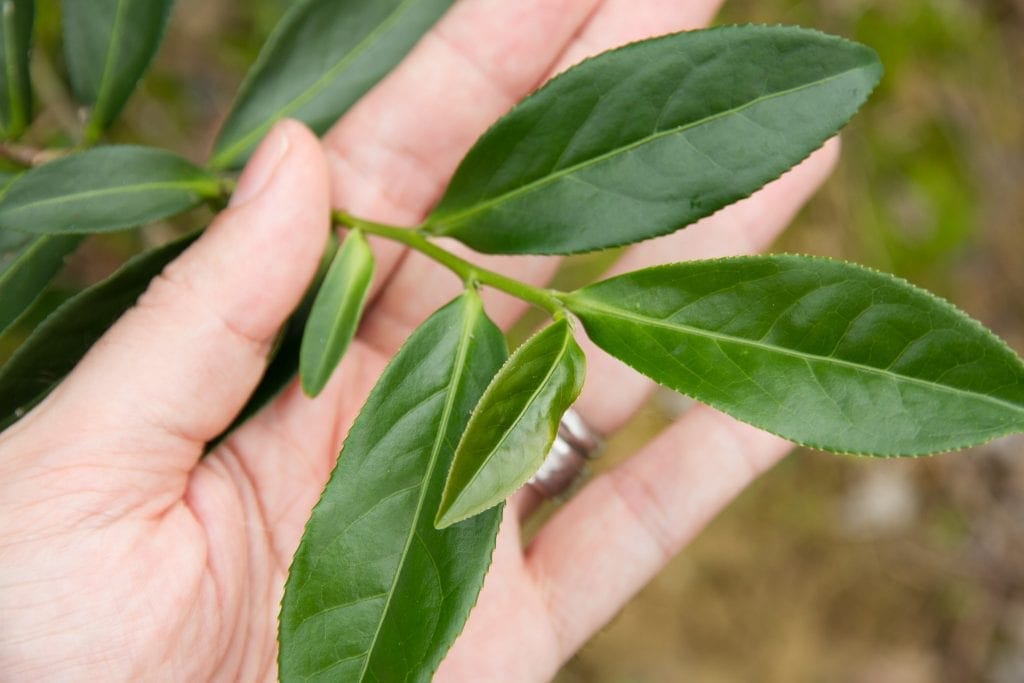
Taiwan is known for its tea. It produces some of the best teas in the world, and Taiwan’s high mountain teas (a term specific to Taiwanese teas) have even been called the “Champagne of oolong tea.”
Please note, if you represent a tea shop outside of Taiwan and are looking for connections to tea farmers or organic teas in Taiwan, I’m sorry that I don’t have any specific leads (I often receive emails about this).
Table of Contents
Best Tea Tours in Taiwan
There are some great tea-related attractions that you can explore as day trips from Taipei, which I will cover in detail in this article. This Taipei tea tour includes a visit to Taiwan’s largest tea museum and a tea plantation with phenomenal views in New Taipei City, while this tour focuses mainly on the tea plantation.
This similar tea day tour also includes the Maokong tea growing area in Taipei City. Get a TWD100 discount on this or any other Klook activity by signing up with this link first.
Learn about the different types of Taiwanese tea and tea ceremony in this tea tasting class. If you prefer being on your feet, try this customizable walking tea tour, which takes place in one of my favorite Taipei neighborhoods, Dadaocheng.
In southern Taiwan, this day tour from Taitung includes a visit to a tea growing area in Luye.
If you’d like a fully customized tea tour of Taiwan, I recommend Life of Taiwan. They run high end tea tours staying in some of the country’s top hotels, but with high personalized experiences such as meeting tea farms and touring tea farms and enjoying tea ceremoney in natural locations. If you contact them, please let then know that Nick sent you over.

Some Tea Basics
Despite all the varieties available, all true teas are brewed from cured leaves of the same plant, Camellia sinensis. Tea originated in Southwestern China, becoming a popular recreational drink during the Tang Dynasty (AD 618-904), then spread to other parts of Asia. Tea didn’t become big in England until the British began cultivating it in India in the 17th century.
The two main varieties of tea are Camellia sinensis var. sinensis (Chinese tea) and Camellia sinensis var. assamica (Indian tea). Caffeine levels vary in tea, but contrary to what some say, your typical cup of tea has less caffeine that a cup of coffee. Tea may be higher in caffeine by volume, but quite a bit less tea leaves are used than coffee beans to brew a single cup.
In China and Taiwan, tea is traditionally consumed hot and with nothing added. It is more commonly enjoyed as an afternoon refreshment for social gatherings, either at home or in traditional tea houses. The tea is prepared according to some very particular steps that have been perfected over centuries, which is sometimes called kung-fu tea, or Chinese tea ceremony, but is not as “ceremonial” as the Japanese tea ceremony. It’s merely the process for preparing each tea in the manner which best brings out its aroma and flavor.
While the majority of Chinese and Taiwanese teas are unflavored, you may encounter some with flavors, which may be real or artificial. Popular ones include jasmine (茉莉) and lychee (荔枝). Herbal (花草茶), fruit (水果茶) and flower (花茶) teas are also common in China and Taiwan, but are not true teas.
Many factors affect the characteristics of a tea, including climate, altitude, water, and soil, but what separates them into the main varieties is the method of post-harvesting production.
Many Taiwanese teas have been transplanted from China, but with a new terroir, they take on new characteristics, and some varieties have been developed only in Taiwan. Typically, they are named after the place where they are grown, for example, Alishan High Mountain tea comes from the area around Ali Mountain, but in some cases when seedlings from the original place are grown elsewhere they may still be given that name.
A Short History of Taiwanese Tea

Taiwan actually has an indigenous tea that early settlers found growing in the mountains and being used by the aboriginals. Some believe that it may be a tea variety of its own, Camellia formosensis.
Camellia sinensis (Chinese tea) was first brought over to Taiwan in the 19th century from Fujian province in China, where the famous Wuyi tea region is located. Many of Wuyi’s teas are known as yancha (rock tea or 岩茶) after the distinctive rocky terroir they are grown in). Oolong tea was found to grow particularly well in Taiwan after it was planted in the Lugu area of Nantou and in northern Taiwan.
Following the First Opium War and Treaty of Tianjin, Taiwan was forced to open its ports to trade with the West. Tea became a major export, and around the time the capital of Taiwan was moved to the north, a thriving riverside port called Dadaocheng developed around the tea trade. The neighborhood remains one of the best places to experience Taiwan’s tea culture. See more details in my walking guide to Dadaocheng neighborhood and see some of Dadaocheng’s incredible temples in my guide to the best temples in Taipei.
After Taiwan became a Japanese colony in 1895, the Japanese shifted from oolong to black tea production in Taiwan to compete with the British. They planted Camellia assamica (Indian tea) in the Sun Moon Lake area (see my complete article on Sun Moon Lake’s incredible black teas).
The Japanese also established the Tea Research and Extension Station in 1903, which sought to develop new cultivars and improve or perfect existing ones. To this day, the institution has developed 22 or more new cultivars, some of which are internationally sought and even grown in other countries, such as Thailand. See more details on that in my guide to tea in Thailand.
After the Japanese left in 1945, production of black tea dwindled, but a small industry remains, with Ruby Red (TRES tea #18), which is a cross between native Camelia formosensis and Camelia assamica from Burma, pretty much universally accepted as the best black tea made in Taiwan, thanks to its very unique minty and cinnamon notes.
The Push to Go Higher
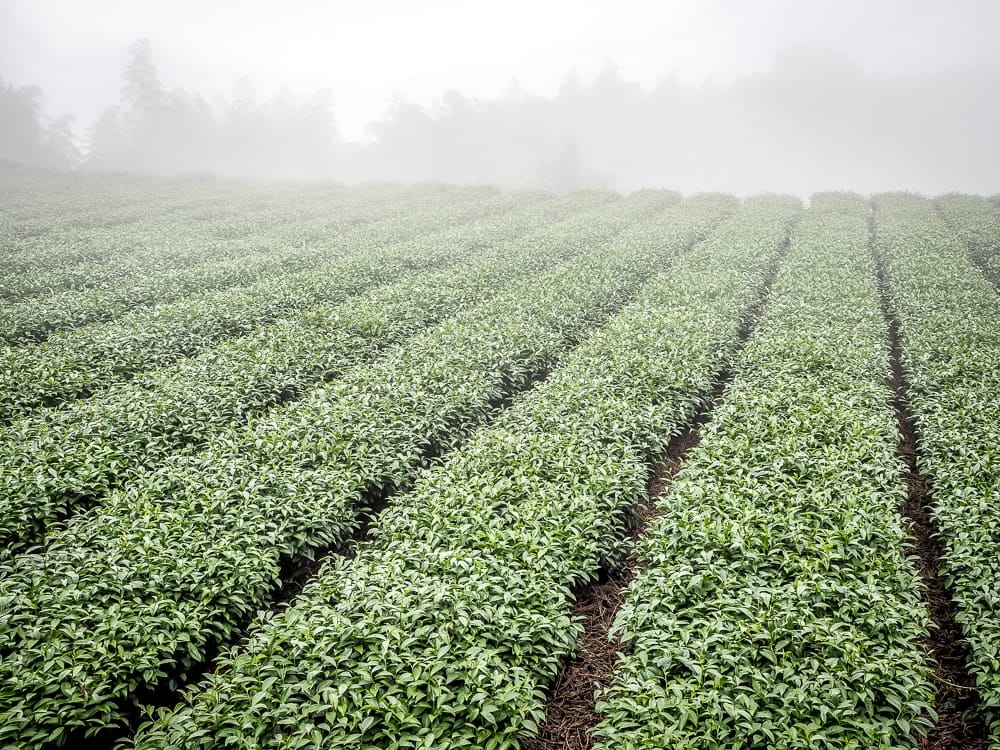
Starting in the 1980s, the TRES and Taiwanese government began encouraging local farmers to experiment with growing tea at higher altitudes. Little did these early pioneers know that they were onto something that would have a massive impact on the Taiwanese tea industry.
The oolong tea grown at higher altitudes was found to have an incredible flavor. Lower amounts of oxygen in the air meant that the tea plants grew slower, with flavor chemicals becoming more concentrated in the leaves. Damp air from the sea and misty slopes of the Central Mountain Range were found to produce teas so fine, the name High Mountain Tea was coined. The Alishan region was the first testing ground, and even today, Alishan High Mountain Tea remains the most famous. See more details in my guide to Alishan’s teas.
Teas grown at 1000 meters of higher are considered high mountain, and most of Alishan’s teas grown around 1000-2000 meters. However, farmers have tried to go even higher in other parts of Taiwan, under the assumption that the higher you go, the better the tea will test. Some of Taiwan’s most expensive teas are grown as high as 2600 meters at Dayuling.
High mountain tea farming is known to be bad for the environment, as it leads to deforestation and soil erosion, so the government is even dismantling some of its high mountain tea farms. What’s more, demand for Taiwanese teas far exceeds production, which has even led to the phenomenon of “counterfeit” Taiwanese teas, which are typically grown in Southeast Asia.
In fact, Taiwan produces such a limited amount of tea that almost none of it is exported, and the country has to import a large amount of tea to meet local demand, particularly for bottled and iced tea beverages, which are massively popular among all ages in Taiwan.
This is why you may find that tea from Taiwan is quite expensive by international standards, and export is mainly limited to small artisanal distributors like Eco-Cha. It’s just really damn good, and there isn’t much of it.
Main Varieties of Tea
The amount of oxidation, or fermentation, that tea leaves undergo after being harvested determines the variety of tea. The following are in order from least to most oxidized.
White Tea (白茶)
This is the least processed of all teas and has an extremely mild flavor and light yellow color (the name “white” comes from the tiny silvery-white hairs found on the unopened buds of the plant). White tea comes from Fujian province in China, and as far as I know it is not produced in Taiwan.
Green Tea (綠茶)
Like white tea, green tea is totally unoxidized, but has a stronger flavor. Green teas tend to be sharp and possess citrus or vegetal undertones. It is believed that by roasting or pan-firing the leaves immediately after harvesting, they retain much of their natural flavor.
China and Japan produce most green teas. Taiwan produces some green teas, but they are far less common than oolongs. A flavored green tea I’ve come across often in Taiwan is sweet osthmanthus green tea (桂花綠茶).
Oolong (Wulong) Tea (烏龍茶)
Oolongs are semi-oxidized teas, generally ranging from 10% (lighter, closer to a green tea in characteristics) to 80% (darker, more robust, closer to a black tea). As such, oolongs are highly varied. They can be steeped multiple times, and each steeping produces different flavors. Taiwan’s oolong teas are prized by tea connoisseurs around the world and can fetch astronomical prices.
Black Tea (“Red Tea” in Mandarin) (紅茶)
Black tea leaves are fully oxidized, giving them the most robust flavor. They are the most common kind of tea consumed in the West, and produced mainly in India and Sri Lanka, though China does produce some as well. Many of them are blends, and sometimes flavors are added (for example the addition of oil of bergamot to produce Earl Grey tea). Sun Moon Lake’s black teas are the best in the country, especially Ruby Red #18.
Another type of Taiwanese black tea that has become increasingly common in recent years is honey-scented black tea (蜜香紅茶). The honey scent is a natural aroma that results from the bites of little bugs on the leaves, just like the more famous Oriental Beauty (see below).
Pu Er Tea (普洱茶)
Pu Er tea is a fully fermented, aged tea that is unique to Yunnan province in southwestern China. Pu er is truly “black” tea, being extremely dark, earthy, and robust in flavor, and it often comes packed in large dense round cakes like in the picture below.
It is very easy to find in Taiwan but it is not produced here. You can even find mini one-pot sized balls of it (center of below image) in Dadaocheng tea shops.
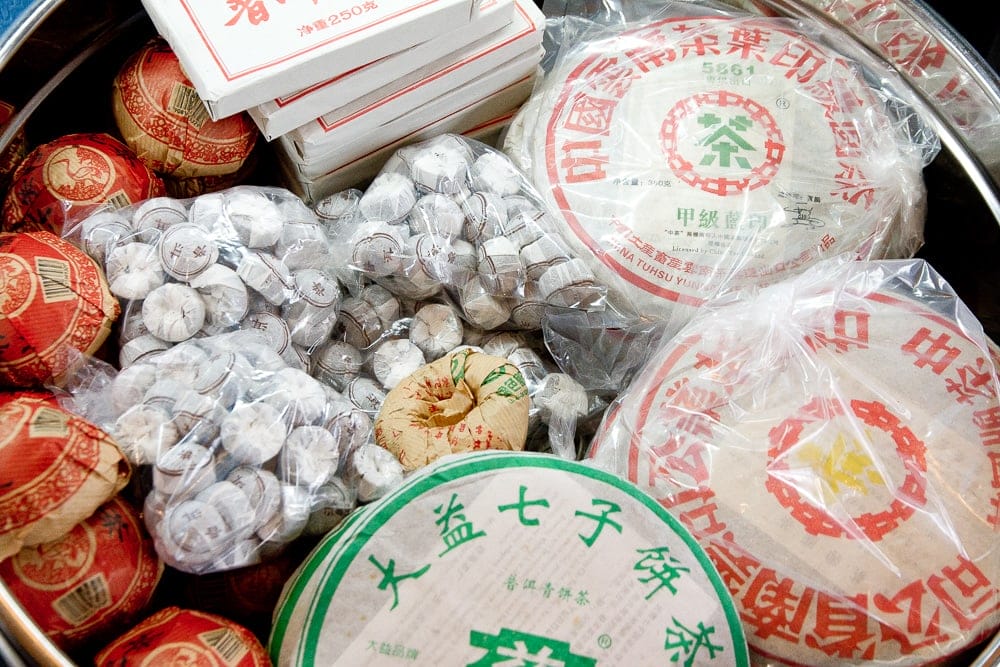
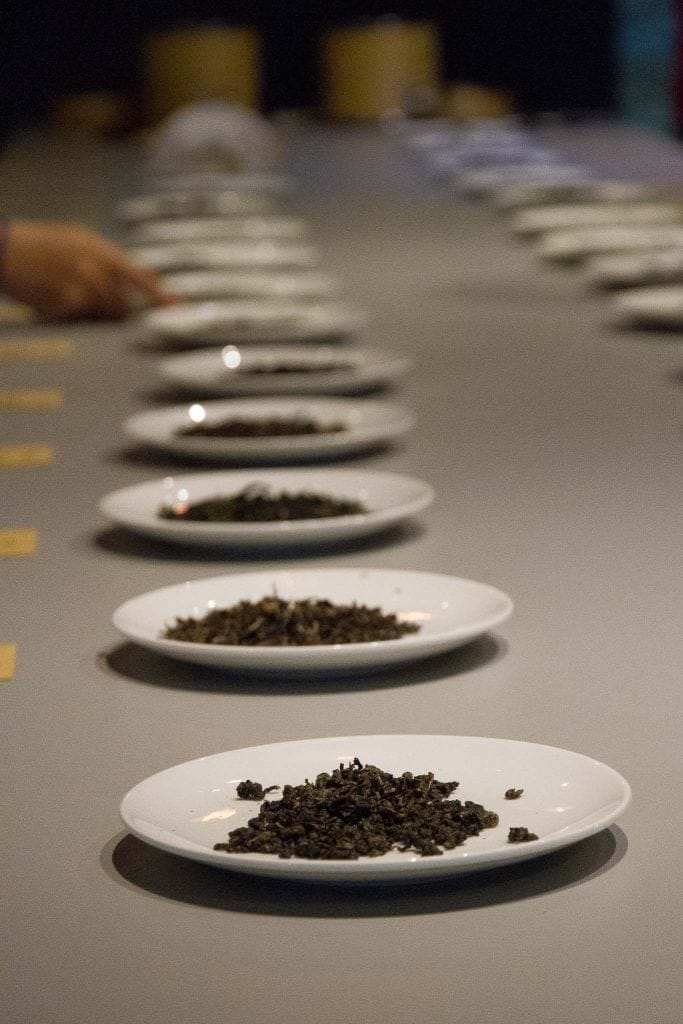
Taiwanese Oolong Tea: Taiwan’s Best Tea
The high altitude, humid, and misty mountains of Taiwan provide the perfect growing conditions for oolong tea. Taiwan’s oolong teas account for 20% of world production. More than 25 varieties of tea are grown in northern Taiwan alone, and most of them are oolongs.
Taiwan hosts annual tea tasting competitions, and the winning teas can fetch prices as high as 1000 USD per kilogram or more. The following are some of the most common varieties found in Taiwan:

Baozhong (or Pouchong) “wrapped variety” (包種茶)
This Taiwanese oolong tea is lightly oxidized (15-25%) so it is light, floral, and has a melon aroma. It is produced mainly in the Pinglin (坪林) and Nangang (南港) districts greater Taipei. Baozhong originated in Fujian province and is named after the unique square packages that it comes wrapped in.
You can tour Baozhong tea-growing areas from Taipei. Baozhong tea is a personal favorite of mine.
Iron Goddess (Tieguanyin) (鐵觀音茶)
Named after the Goddess of Mercy, this tea also originated in Fujian, but is now commonly grown in Taiwan, especially in the Maokong area of Taipei city. There are many varieties, and they vary from light to medium bodied. It is usually heavily roasted, imparting a “toastier” flavor.
Alishan High Mountain (阿里山高山茶)
Alishan is not only famous for it’s misty mountains and sunrises above seas of clouds but also its fine high mountain tea. Traditionally revered by locals as Taiwan’s best tea, this tea deserves it’s own article here.
Alishan tea is usually around 40% oxidized, so it is light to medium in color. The tealeaves are usually rolled into dense little balls that unfold when you add hot water. It has a creamy mouthfeel that seems to coat the mouth, and a sweet, long-lasting aftertaste.
Alishan high mountain tea is sold for as high as 400 USD per kilogram. Also see my comparison of Alishan and another Taiwanese oolong tea, Dong Ding.
Dayuling (大禹嶺)
Near the famous mountains of Hehuanshan and Lishan in the Central Mountain range, Dayuling’s insanely high prices are related to the mountain’s remoteness, high altitude (2200+ meters), and the small quantity that is produced as much as it is to the fact that it frequently wins tea competitions.
This is the most expensive of Taiwan’s teas, at up to 1000 USD per kilogram. I’ve had the honor of trying it, and can wholeheartedly confirm that this this stuff is good!
Oriental Beauty (東方美人 or Dongfang Meiren)
60% fermented, this unique tea has an amber color and earthy characteristics. Little bugs called tea grean leafhoppers are intentionally left on the leaves when harvesting, as their bites initiate early fermentation that lends that tea an incredible honey flavor.
Dried oriental beauty leaves have white tips, so it is sometimes called “white tipped oolong”. In a market where high mountain oolongs reign supreme (which personally I kind of get bored of sometimes), Oriental Beauty is refreshingly different.

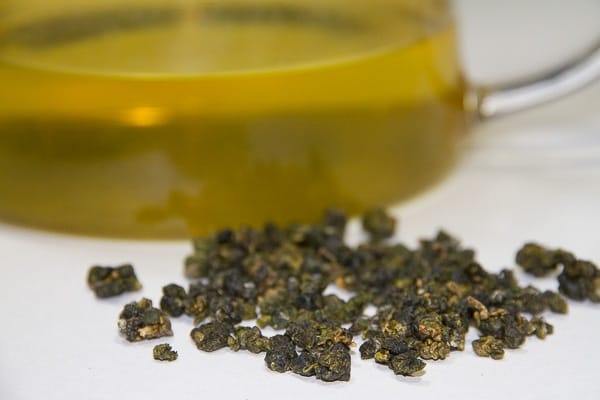
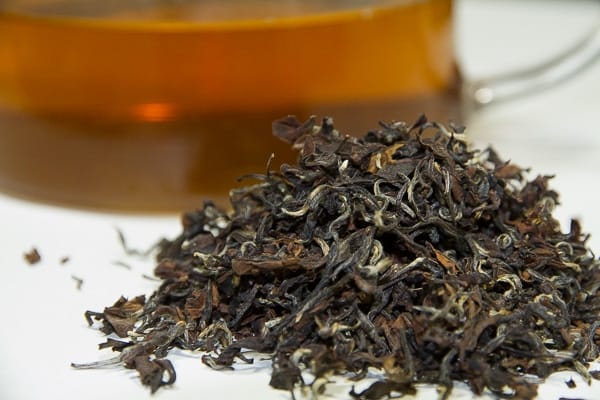
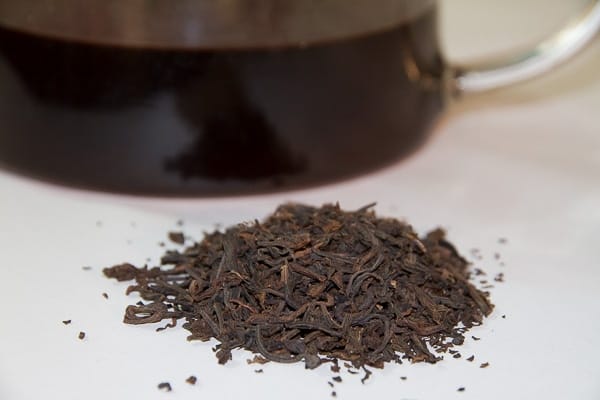
How to Order Tea from Taiwan
A solid choice for buying Taiwan tea online from anywhere in the world is Eco-Cha, which sells artisanal teas from producers that practice sustainable farming, and has a great tea of the month program. Use this link to browse their teas and get 10% off your Eco-Cha tea order or enter the discount code NKTEA when you check out!
Global Tea Hut, an international meditation and tea center run by an American monk and tea expert and headquartered in Miaoli, Taiwan, also has a great tea of the month + tea magazine program. The magazine is extremely information and I would highly recommend it for tea (and meditation) lovers who want to take their love of a tea to a higher level.
I wrote a whole article about an inspiring visit that I had to the Global Tea Hut’s meditation center, Tea Sage Hut.
Where to Buy Tea in Taiwan
One interesting method for buying tea in Taiwan is to visit a tea producing area and buy tea directly from the growers or in local shops in that area. Easily accessible tea growing areas include Sun Moon Lake, Alishan, and Luye. Buying tea in this way creates an association in your mind between the tea and your experience in that area, making it all the more enjoyable when you brew it later. See more details about these regions below.
You can find many stores specializing in Taiwanese tea in all the major cities, many tourist centers (especially Alishan and Sun Moon Lake), and even at the airport and in most grocery stores. Just beware that with such high demand for certain Taiwanese teas, like Alishan High Mountain tea, some tea that is now sold as these varieties is actually grown outside of Taiwan, such as in Vietnam.
If you are not in Taiwan or able to travel to around the island, try ordering Taiwanese tea online from the sites I mentioned above, or see below for the best place to buy tea in Taipei. Truthfully speaking, though, I can’t imagine any teas sold in Taiwan are ever really ‘bad.’
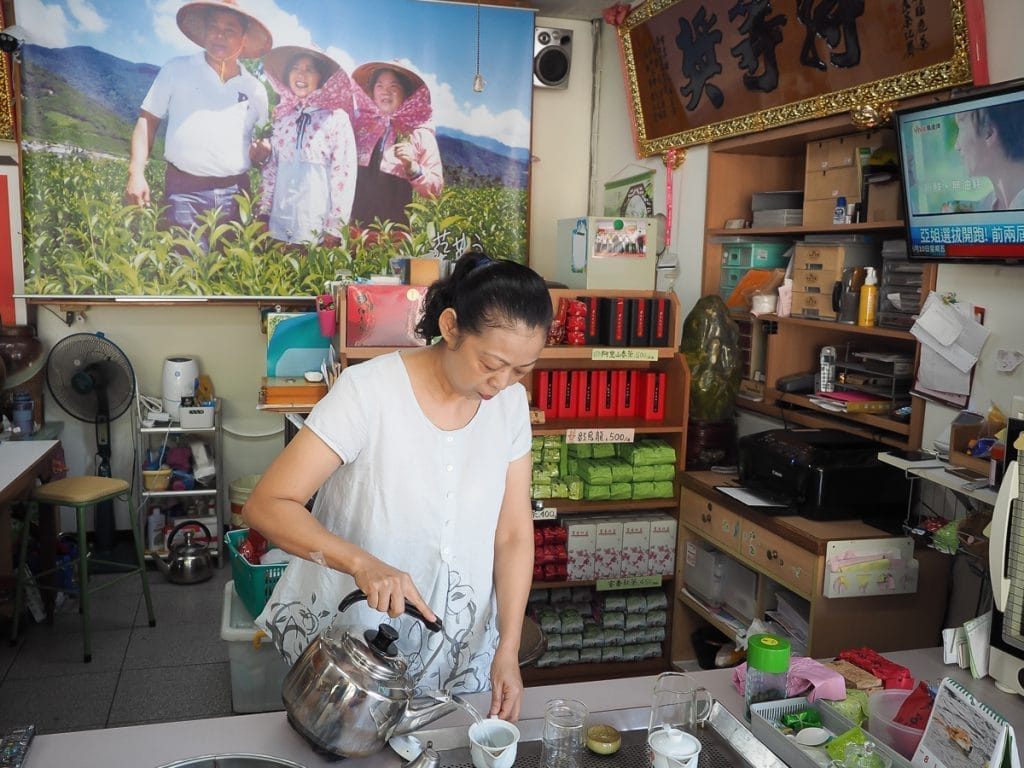
Where to Buy Tea in Taipei
My favorite place in Taipei to buy tea in Taipei is the Lin Mao Sen Tea Co 林茂森茶行 (195-3 Chongqing N Rd, MRT Daqiaotou 重慶北路195-3號,捷運大橋頭站). The clerks speak impeccable English and can describe all the characteristics of the teas to you before you buy. There are dozens of varieties on display in large metal barrels, and the main local varieties are sorted according to quality, ranging from very cheap to very expensive.
Right next door, and owned by the brother of Lin Mao Sen, is competing Lin Hua Tai Tea (林華泰茶行). The shop isn’t as fancy looking, but the product seems to be almost identical, with a similar range of qualities and prices.
Tea, just like most dried goods and produce in Taiwan, is sold by the jin (斤). One jin is equivalent to 600 grams. For most of the varieties mentioned above, the highest quality goes for NTD4000 (120 USD) per jin, the second goes for 2400 per jin, the third for 1600, and so forth, with the cheapest ones going for as low as NTD60 per jin.
The lowest quality ones are mostly stems and powder, while the highest ones have the largest concentration of perfect leaves. If you want even lower than the lowest quality, go to your local supermarket and buy a box of teabags. The minimum purchase at Lin Mao Sen is a quarter of a jin, or 150 grams (150 公克). They are also familiar with Western units of measurement.
It’s interesting to compare the size of a 150g bag of, say, light fluffy baozhong to the same amount of Alishan High Mountain, which is rolled into dense little balls. The bag of baozhong will be about three times as big!
Personally, I always go for the third or second highest quality. This is still VERY good tea, and I think only a true connoisseur would be able to tell the difference between the top three qualities, yet the price drops enormously between each of them. NT400 (12 USD) gets me a decent-sized 150g bag of (third quality) tea that lasts me for at least a few months, and if I get a few different bags, I’m good for a year.

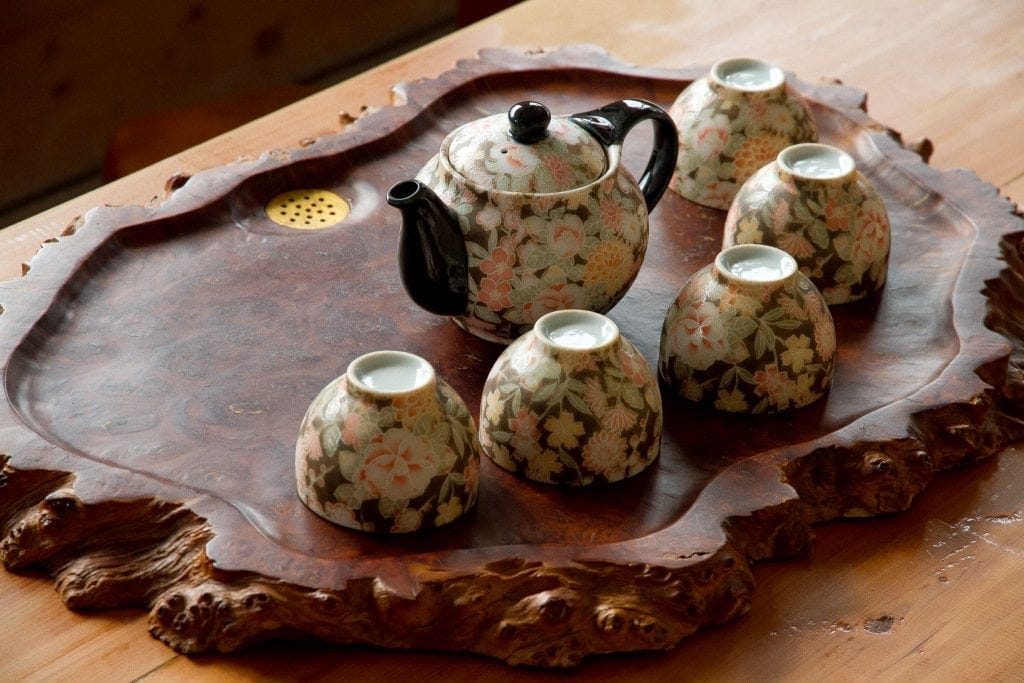
Another very interesting place to buy tea in Taipei is Wang Tea (有記名茶) (#26, Lane 64, Section 2, Chongqing North Road, 大同區重慶北路二段64巷26號), which is only a few blocks away from Lin Mao Sen and Lin Hua Tai in historic Dadaocheng area. This tea shop was established over 100 years ago and specialized in Baozhong and high mountain oolongs.
But the coolest part is that they are the only remaining shop in Taipei where the tea leaves are roasted in the traditional manner over hot coals, right inside the shop!
You can visit the back room where they do this, and if you are lucky enough to visit during one of the roastings, there will be a wonderful smell. If you want to buy tea there, you can sit down to a private sampling session with an expert.
Wang Tea faces Chaoyang Tea Park (朝陽茶葉公園), around which there are several other old tea shops.


Another interesting place you can buy good tea in Taiwan is the Taipei Expo Farmer’s Market, which takes place beside Maji Square at Yuanshan MRT station every Saturday and Sunday 10am to 6pm. Most of them will let you taste their brews before buying. They aren’t there every time, but sometimes there is a stall that specializes in Pu Er teas imported from China.
Looking for a place to stay in town? Don’t miss my guide to the best hostels and hotels in Taipei.
Taipei Teahouses
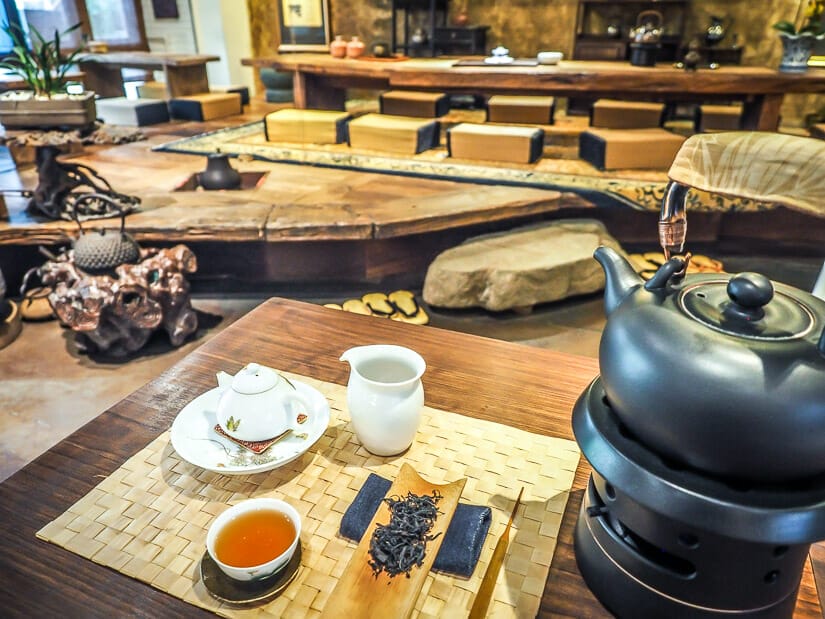
Traditionally, tea drinking is a relaxed, social affair in Taiwan and can last for hours. In old times, people would head to the local teahouse (茶館), or brew tea on their living room table or in front of their homes. These days, coffee is way trendier in Taipei and cafés serving quality coffees are popping up everywhere.
In terms of day-to-day consumption, most busy Taiwanese drink bottles of iced tea from 7-11 or pearl milk tea-type concoctions from tea shops these days. Coffee is now way trendier in Taipei and cafés serving quality coffees are popping up everywhere, but most families and especially elderly people will still bust out the tea set when they have friends or relatives over.
Since it’s not easy for travelers to get invited to have tea with a family, your best way to take part in this unique experience is to visit a traditional teahouse. The establishments are dying out in urban areas of Taiwan, but luckily, the Taipei tea house scene hasn’t totally vanished, and you can find several in the Da’An and Yongkang street area. At most, you can expect to pay NT300-600 for a pot of tea, which includes all the equipment needed and enough tealeaves to brew multiple brews over the course of however long you want to sit there. Keep in mind that you’re not just paying for the tea but also the experience of the beautiful premises.
The most well-known traditional teahouse in Taipei is Wistaria Tea House a few blocks south of Da’An Park. This famed establishment is housed in a Japanese era home that was an underground meeting spot for artists, intellectuals, and dissidents during the later days of the White Terror period of martial law in Taiwan. The staff on hand speaks English and is highly knowledgeable. It is often full so you will want to make a reservation.
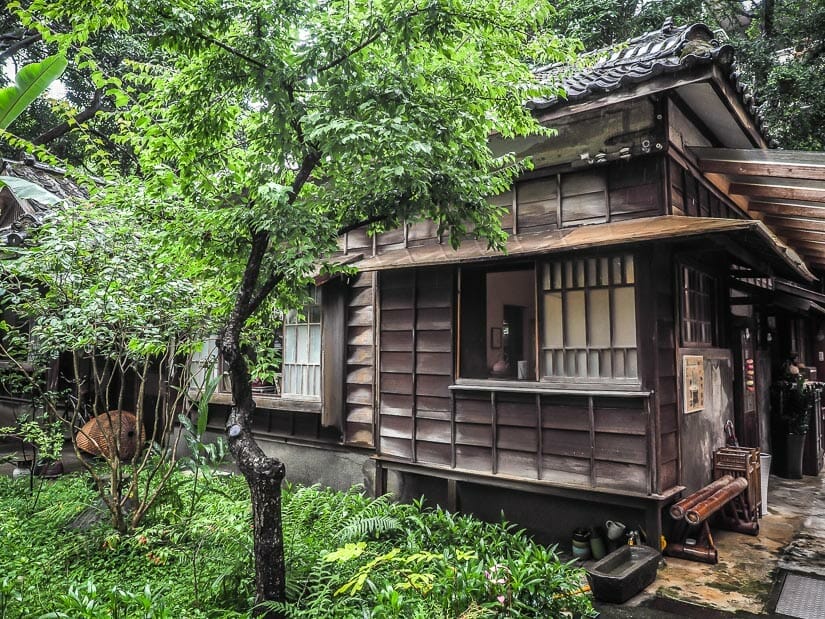
Yongkang Street, famous for its restaurants and food stalls, is also home to several excellent teahouses. See my self-guided tour of Yongkkang Street for more details.
One very easy-to-reach Yongkang Street teahouse is Yashe Yongkang Teahouse (啞舍永康). The price starts at NT320 per pot of tea. Add 180 for a second person. There’s a long list of Taiwanese teas available. It faces Yongkang Park. Stop By Tea House (串門子茶館) is another in the area.
If you walk 10 minutes south of Yongkang Street, there’s a beautiful area of Japanese-era houses that used to house professors at NTU when it was a Japanese institution. It’s a very lovely and off-the-beaten-track neighborhood to explore in Taipei.
One of those now houses a beautiful teahouse, called Qingtian Teahouse (starting at TWD 450/person). Another right beside it is Hehe Qingtian Teahouse (和合青田, 600/person, reservation required).
The latter two are housed in gorgeous Japanese-era homes and come with guided tea brewing and a tour of the premises.
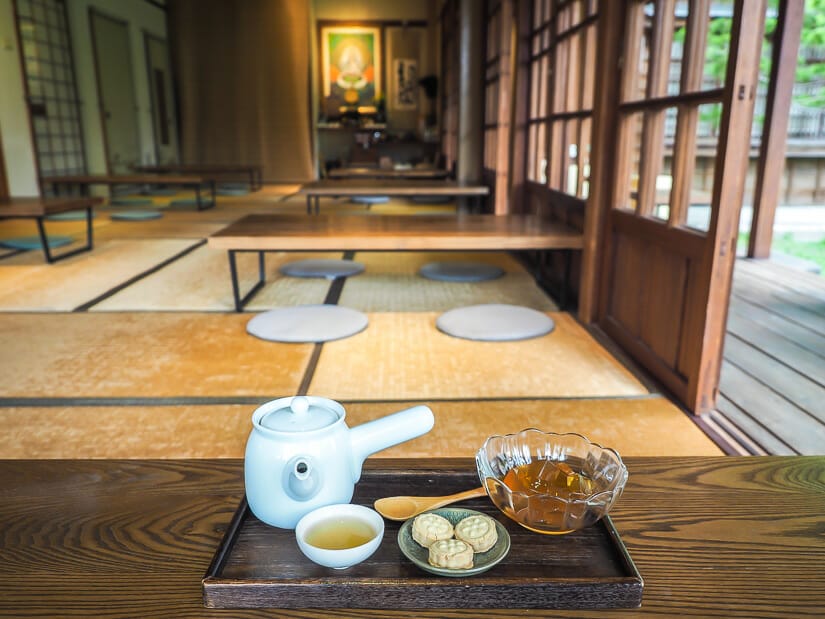
Yet another great option is Eighty-Eightea Rinbansyo (八拾捌茶輪番所), also housed in a Japanese era wooden house, but not as pricey as the above two. It is conveniently located in Ximending district, in a square that also features a Japanese shinto shrine. A pot of tea with choice of two snacks goes for NT350. Also find places to eat in the area in my Ximen food guide.
Maokong (see below, in Tea Tours section) is also a great place in Taipei with many traditional tea houses in rural natural surroundings overlooking Taipei.
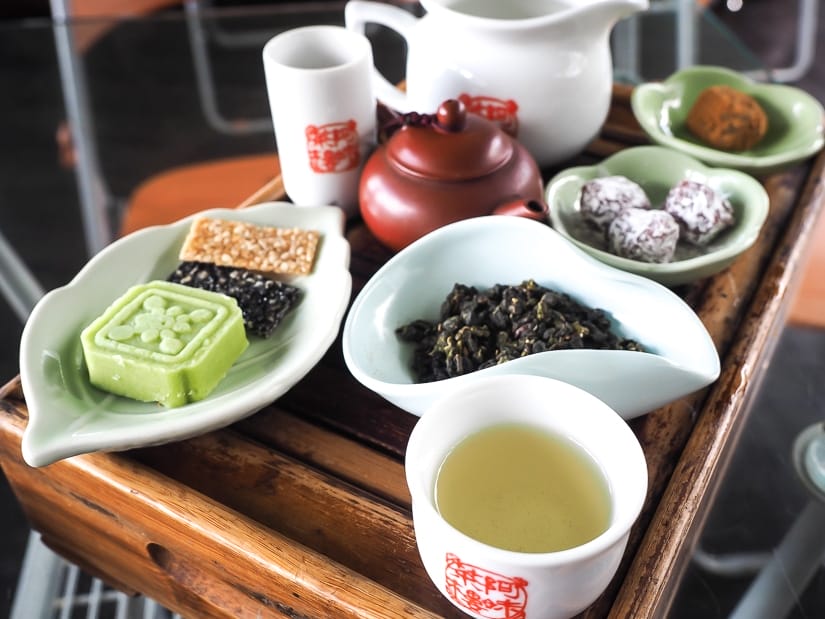
In New Taipei City, Jiufen is a popular old mining village turned into tourist resort town, and a probably the single most popular of the many day trips from Taipei. It’s quite touristy, but also has some historic, incredibly atmospheric teahouses. Amei teahouse is the most famous one (you’ll want to pre-order your tea set online to guarantee a spot) but there are several others.
Find all the details in my guide to Jiufen and information on how to get to Jiufen here.
Tea Attractions around Taipei
Terraced tea fields are highly photogenic places, and there are many places in Taiwan, even as easy day trips from Taipei, where you can get up close to admire their simple beauty. Taiwan is also home to several interesting and informative tea centers and museums.
There are a few tour operators offering tea tours across Taiwan (a simple google seach will help you there, but I can’t recommend one personally). The below tea-related attractions can all be visited on your own, but I’ve mentioned organized tours where they do have them.
Taipei Tea House, Jiuzhuang (舊莊), Nangang District
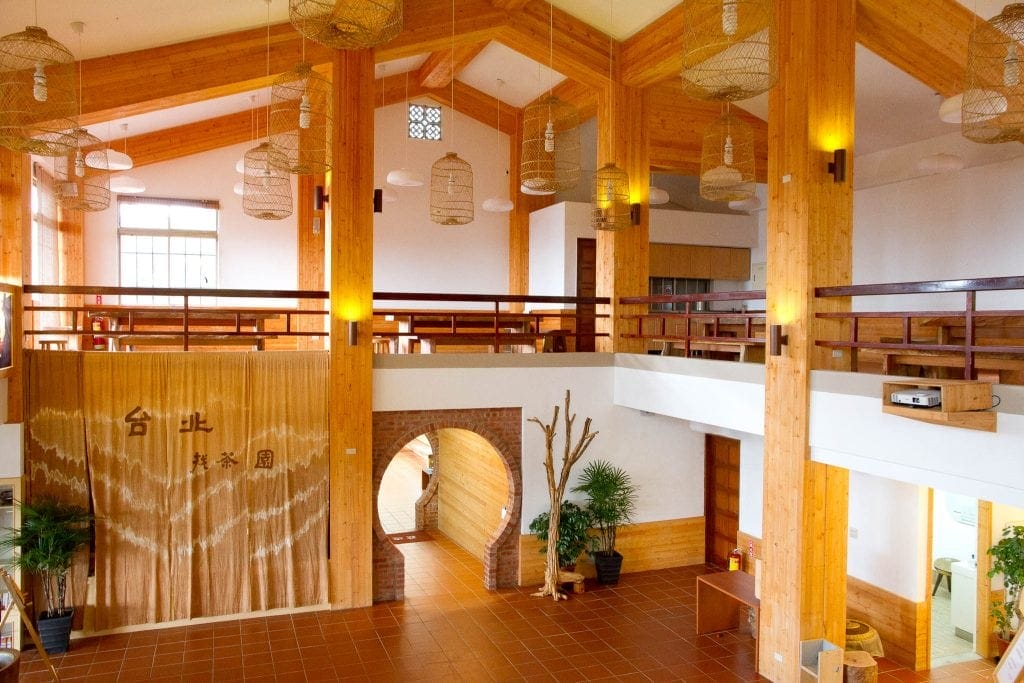
In the foothills of Nangang district, eastern Taipei City, Jiuzhuang is the first place that grew Baozhong tea in Taiwan. In early 2014, a new tea center called the Taipei Tea House, also called Nangang Bouchong Tea Center (台北找茶園 or 南港茶葉製造示範場) was opened here to showcase local tea.
The modern, zen-like facilities feature large wooden tables, Western- and Japanese-style private rooms, and great mountain views in the distance. Tea processing equipment and educational exhibits are also on display. On weekends the center also leads eco-tours and holds tea-themed activities.
Across from the Taipei Tea House, there is a restaurant called Guanyun Residence Tea Plantation (觀雲居茶莊), with a patio surrounded by trees. They serve a variety of tea-infused dishes, such as tea oil noodles and tea stewed chicken. You can also visit the family-run Qinming Tea Plantation (欽明茶園).
Overall, Jiuzhuang makes for a pleasant 2-3 hour trip from the city and offers a good introduction to Taiwan’s tea culture. There are some nice walking trails in the area with lovely views over terraced tea fields. The Taipei Tea House is quite new and as far as I know isn’t in any travel guidebooks yet, so you are unlikely to see any other foreign visitors there.
Getting There: Catch small bus #5 from just in front of Funan Temple (富南宮) near exit 5 of Nangang Exhibition Center MRT. Buses are infrequent, and if I remember correct, the ride takes about 20 minutes.
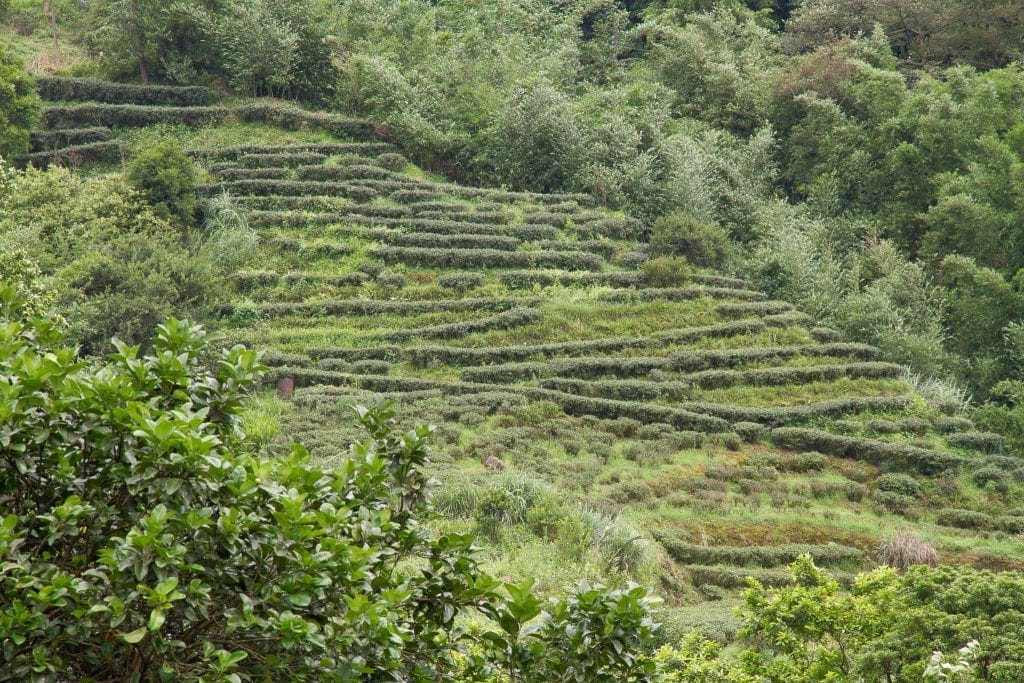


Pinglin Tea Museum (坪林茶業博物館)

Pinglin is Taiwan’s mecca for tea lovers. You can enjoy the best Pinglin has to offer on the Thousand Island Lake and Pinglin Tea Plantation tour, including the tea museum and visiting a gorgeous tea plantation nearby (see below).
Located southeast of Taipei, all Taiwanese know it as the midway point on the old mountainous highway #9 from Taipei to Yilan. Drivers used to stop here to enjoy a cup of local baozhong tea and lunch, until the freeway was opened in 2006, bypassing Pinglin with a series of tunnels.
But now Pinglin has made a comeback by cleaning up Beishi Creek, the waterway which runs through town, and lining it with bicycle paths from which cyclists can admire pools filled with large catfish, and fields of tea (Giant bicycles can be hired in town).
One reason why there are so many fish in the river, and also why the baozhong tea grown in the area is considered so fragrant, is that the entire area is protected as a special water resources zone given the fact that Pinglin is just upstream from the Feicui Reservoir (翡翠水庫), one of two main reservoirs supplying water to Taipei.
Most of the shops in the one-street town sell tea, tea derived products, or foods infused with–you guessed it–tea. Personally, I really enjoyed the deep fried tealeaves, and you can never go wrong with matcha ice cream or tea eggs. Walking down Pinglin’s little old street, note the cute little teapots on the lampposts.
Pinglin also boasts the what is supposedly the world’s largest tea museum, in which you can learn everything you’ve ever wanted to know about local tea, and entrance is totally free. A good place to go if you just want a single cup of tea is the little teashop on the outer wall of the museum near the entrance.
If you want to cycle a little further than the easy paths along the river, peddle to the Jingualiao Fish and Fern Trail (金瓜寮魚蕨步道), a lovely one hour ride. There are also multiple riverside campsites in the Pinglin area.
Getting There: Bus #923 and green #12 go to Pinglin from just outside Xindian MRT station. The ride takes about 40 minutes. Bicycles can be hired in Pinglin town.

For another place to try tea-infused foods in Taiwan, see #38 of my recommended things to do in Yilan.
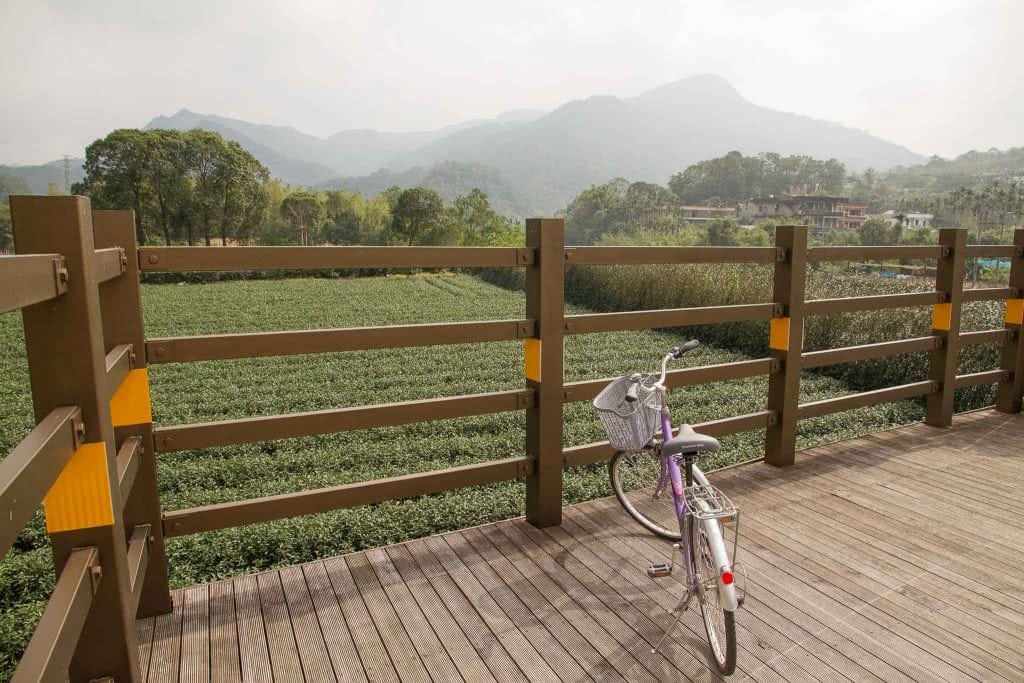
Shiding Bagua Tea Plantation (石碇八卦茶園)
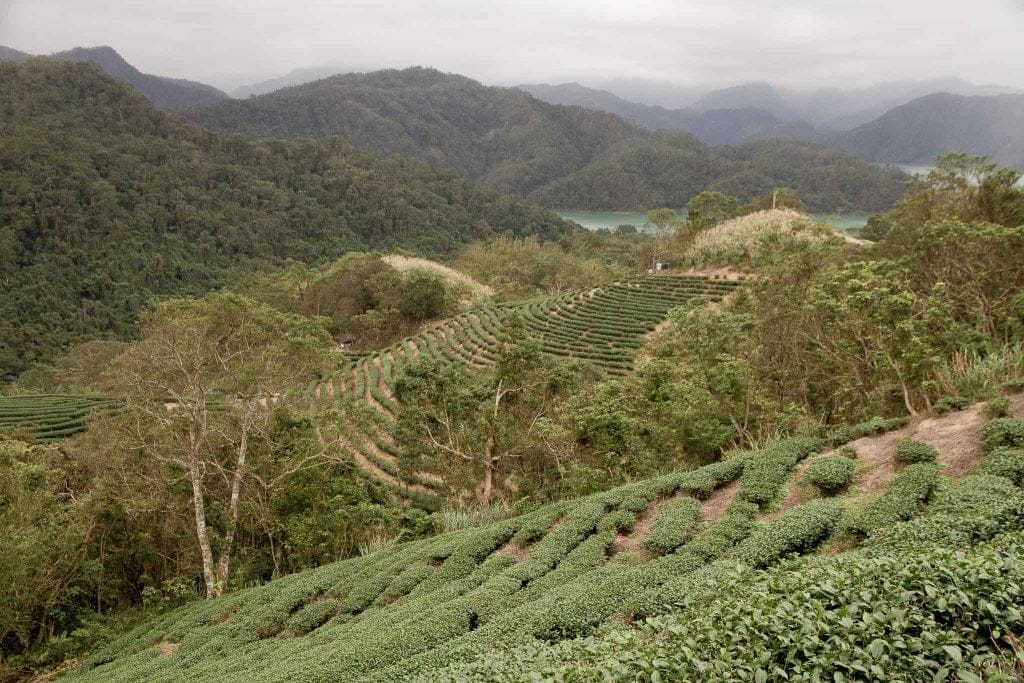
For absolutely stunning panoramic views over the Feicui Reservoir (翡翠水庫), one of two main reservoirs that provides water to greater Taipei, get yourself to this fantastic little spot. The reservoir is also called Qian Dao Hu or “Thousand Island Lake” (千島湖), named after a lake with similar scenery in Zhejiang province, China.
You can get here by taking the bus towards Pinglin, getting off at the nearest stop, then hiking down to find the trail. A much easier way to visit is by taking the Thousand Island Lake and Pinglin Tea Plantation tour, this tea day tour that also includes Maokong, this one that focuses mainly on the tea plantation only, or this hiking and tea-focused tour.
The picture-perfect terraced tea fields rolling down to the turquoise waters of the reservoir with mountains rising straight out of the reservoir form a commanding backdrop. It’s worth the trip!
There’s also a hike in the area that takes in similar views called Yong An Scenic Trail (永安景觀步道).

Maokong (貓空) Tea Houses
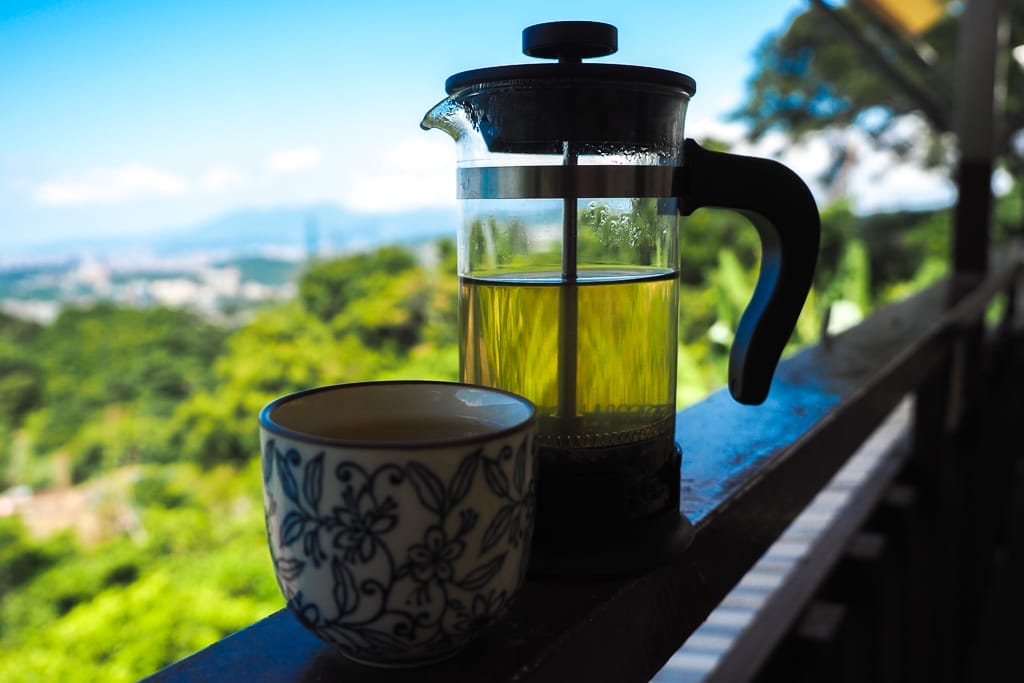
Maokong offers Taipei folk (and lots and lots of tourists) the chance to get up into the tea fields via glass-bottom gondola directly from the Taipei Zoo MRT station, and offers dozens of traditional teashops to choose from. The gondola even passes over some tea fields.
Arriving at Gondola Station, you can do some hikes in the article with views of tea fields, such as the below pictures, or choose from one of dozens of teaditional teahouses in the area. I introduce my favorites in my Maokong guide.
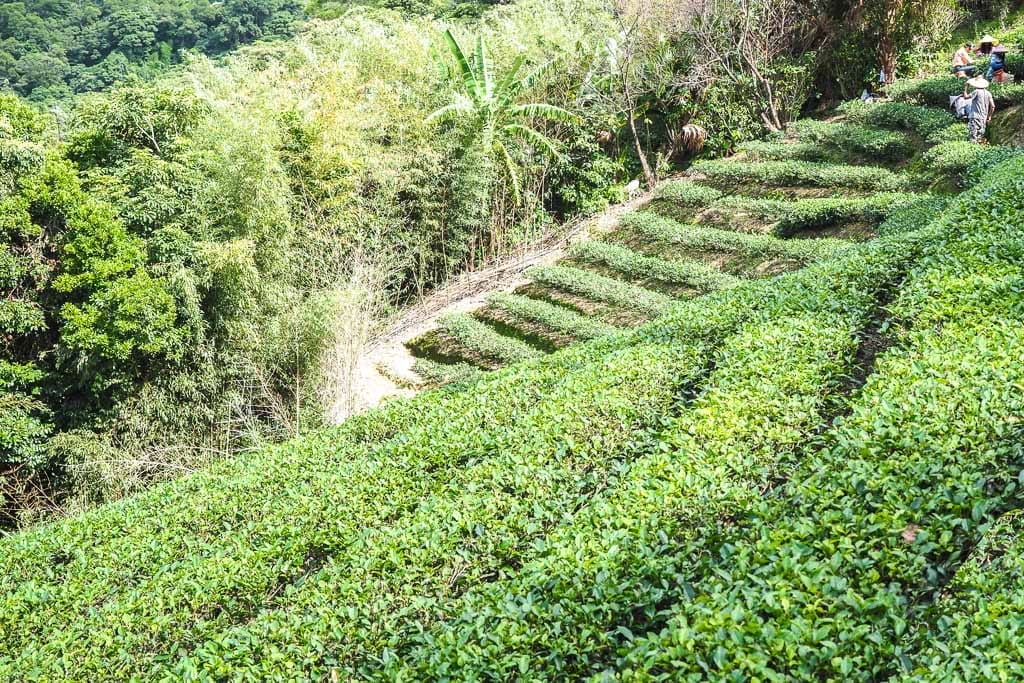
A great way to visit Maokong is on this full-day tea tour that also includes Pinglin.
Visiting Tea Areas around Taiwan
Interest in tea tourism seems to be growing in recent years (based on the number of tours offered and also emails and questions that I get from readers). However, the tea tourism industry in Taiwan is young, and it is not very easy to visit or stay on tea farms around Taiwan. I have spend a lot of time researching this and trying, and below are what I consider the best options.
Shizhuo, Alishan
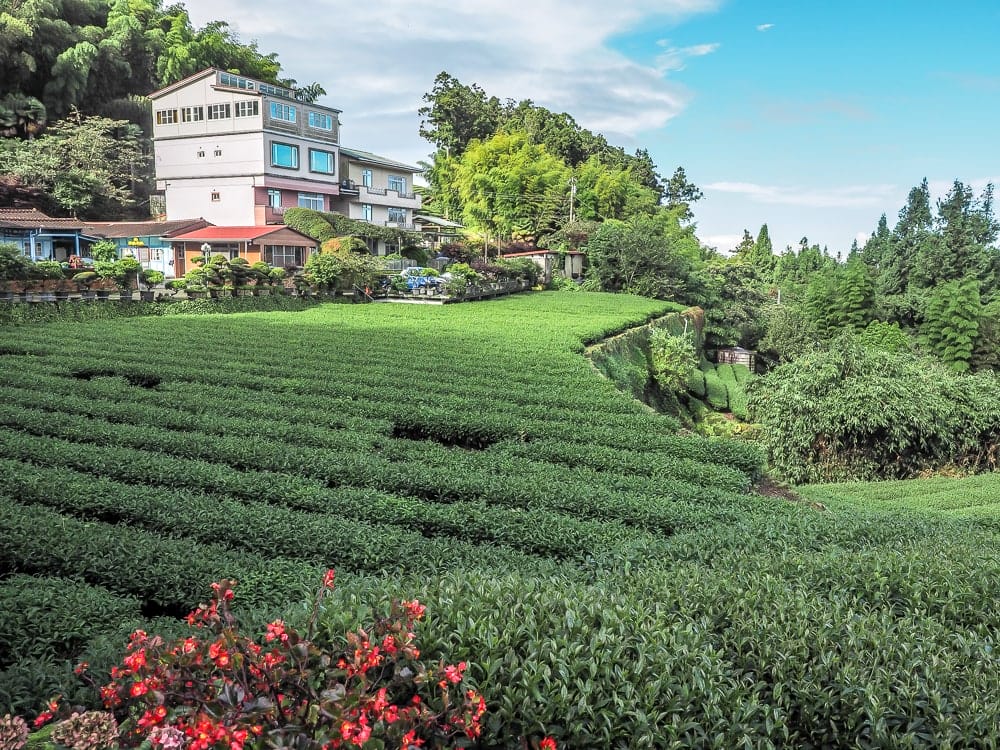
If you want to actually stay on a tea farm, the best (and only?) options I’ve found are in Shizhuo, a small tea growing village near Fenqihu railway station, about half way between Chiayi city and Alishan, and also the current end point of the Chiayi to Alishan Forest Railway line. See my guide to Shizhuo for more details than I’ll provide here.
I had an incredible experience staying at Cuiti B&B (see on Booking / TripAdvisor), a legit Alishan High Mountain tea farm, pictured above and below. There is a network of trails you can hike among the tea farms, and the scenery is phenomenal, so this is truly a paradise for those who are interested in tea tourism. Another very cool hike through tea plantations is nearby, called Eryanping Trail.
See guide to on Alishan for more information about traveling to Shizhuo, Fenqihu, and Alishan, and my complete article on Alishan High Mountain Tea and why it is so popular.
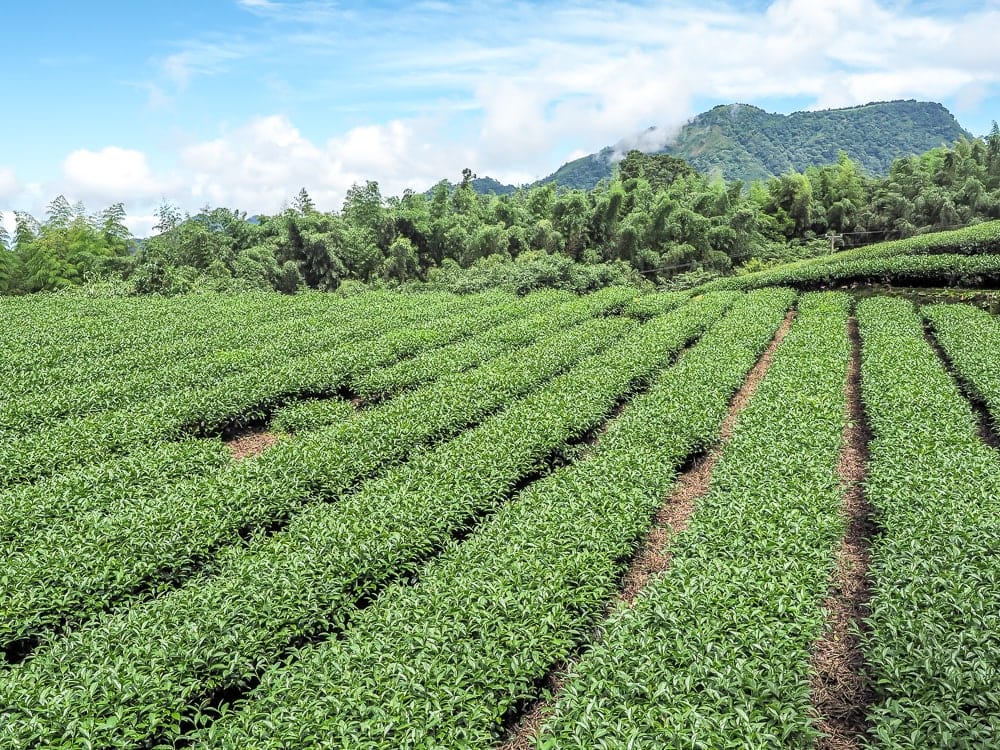
Sun Moon Lake
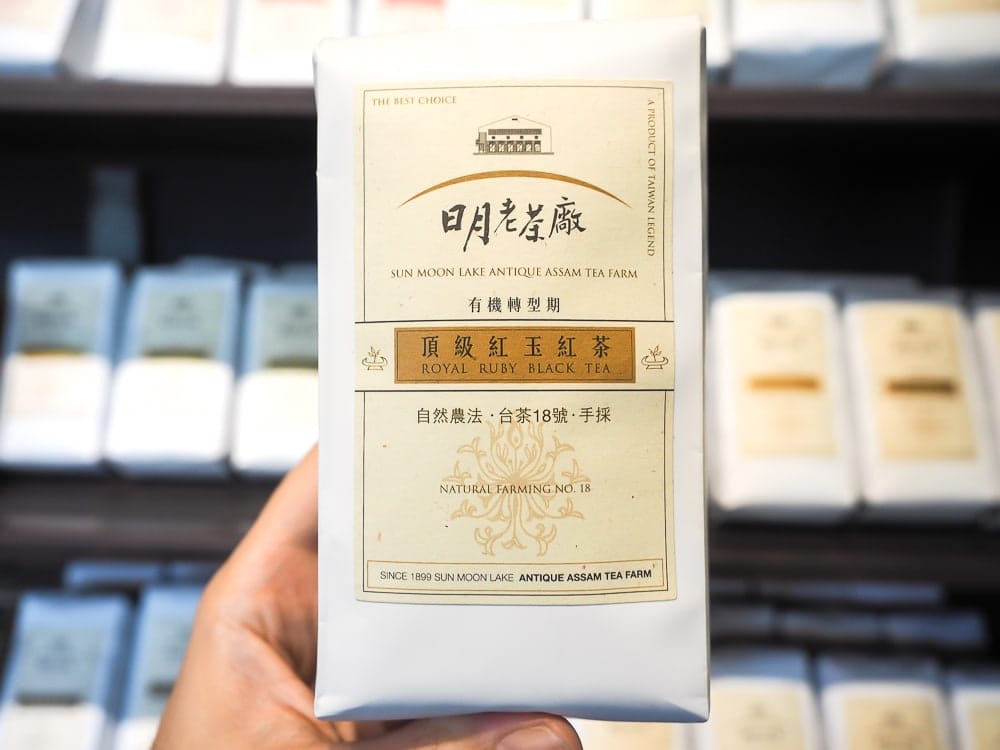
Sun Moon Lake is a gorgeous and popular tourist destination, but the region north of the lake, between Sun Moon Lake and Puli, is also famous for its black teas, especially Ruby Red #18.
Here you can find multiple tea-related sights and activite, most notably the Antique Assam Tea Farm. There is even a tea themed guesthouse, and if you get off the main road and drive up some mountain roads, you can find some beautiful terraced tea farms.
See my article on Sun Moon Lake tea for all the details about these tea-related attractions. Sun Moon Lake can even be visited as a day trip from Taichung.
Luye, Taitung

Another place to see beautiful tea fields or buy tea in Taiwan is Luye, a tiny town (more like a rural area with a train station) in Taitung County. You can read about cool places to visit in Taitung here.
The best way to see the tea fields is to rent a scooter near the train station and then drive up to the Luye Highland. The main teas grown here are jinxuan (milk oolong), red oolong, and honey scented black tea. You can also take this day tour from Taitung that includes Luye.
See my article on Luye, Taitung for all the details.
How to Brew Taiwanese Tea
A typical Chinese tea set like this one you can order on Amazon includes a surprisingly small teapot (茶壺) with a strainer, a tea pitcher (公道杯) for actually pouring the tea (transferring from the pot to the pitcher helps to achieve consistency), miniature drinking cups (茶碗), tongs for removing infused tea leaves, and a large tea tray (茶盤).
For the absolute best choices of teaware and tea sets in Taiwan, you must head to the Pottery Street in Yingge, New Taipei City. You can find anything there from dirt cheap functional ware to authentic traditional sets and modern ceramics artworks. The Yingge Ceramics Museum is also really impressive!
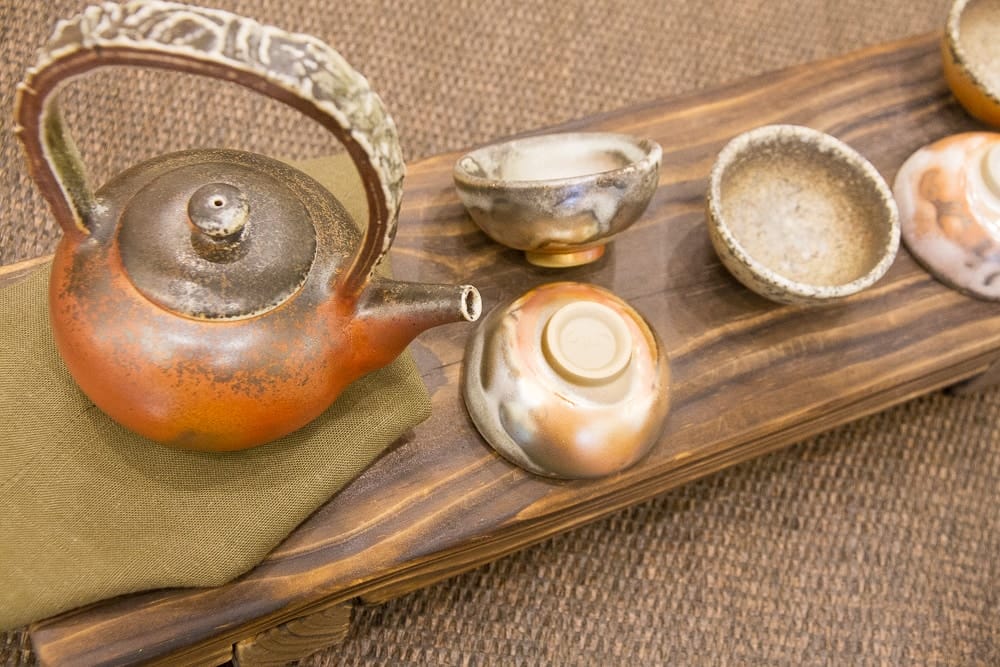
Most locals perform a somewhat simplified execution of the traditional Chinese gongfu tea ceremony (功夫茶) or “skilled tea”. The first step, after bragging about how good your tea is, is to boil some water and add it to some leaves in the small pot to “rinse” or “wash” them, usually for 30 seconds or less.
The “liquor” from this first round is then poured into the cups and then discarded into the tea tray, which typically has drainage holes. This is done to warm the cups, and after the tea is discarded, drinkers can stick their noses into the empty cups to experience the tea’s aroma. The main purpose of rinsing the tealeaves is to get rid of the bitterness.
Next, more water is added to the pot and the leaves are steeped for about 1 minute (or up to two minutes for some darker oolongs, such as Oriental Beauty tea). Also note that the ideal temperature for brewing tea varies according to the tea. The ideal water temperatures for various teas are as follows (according to the Pinglin Team Museum; information online varies slightly):
Ideal brewing temperatures
- Iron Goddess, High Mountain Oolong: 100°C
- Black, Pu Er: 95°C
- Baozhong: 90°C
- Green Tea, Oriental Beauty: 85°C
Oolong teas can be steeped a few times, while pu er tea can be steeped ten or more times. For each subsequent brew, the leaves should be steeped longer. Supposedly, each round brings out different flavors in the tea.
Did you make it this far? Congratulations! Although it may seem like a lot, I feel like I’ve barely scratched the surface of Taiwanese teas here. If you’ve got any comments, questions, or would like to add any information about Tea in Taiwan, please do so in the comments below!


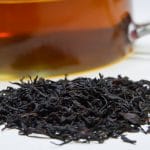
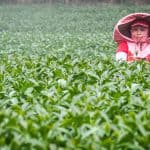
My mother in law always gives us so much tea when she comes to the USA from Taiwan! She’s like a traveling tea saleswoman.
This is a great post! I just came back from a recent trip to Taiwan and I’ve been craving the tea culture I experienced over there. Luckily I picked up quite a few loose leaf teas (Alishan and Dong Ding Oolong specifically) to hold me over until I visit again. But I did hear from people in Taiwan that dumping out the first brew isn’t as common as it used to be. I think some people believe it’s a waste of the tea’s flavor. It’s not totally a dead custom but there are definitely two kinds of traditional tea lovers: those who pour the first brew and those who don’t.
Thank you Nick for the great post! Really well written!
Thank you Tina!
Hi Nick ,
Very informative site. Thank you. I have a question, Would you know of any places to get formal training of tea in Taiwan?
With Apprciation.
Ranie
Hi Ranie, no unfortunately I am not aware of any, especially in English. There are only some short, 1-2 hours introductions to Taiwanese tea culture. You can also look into Global Tea Hut, which offers meditation & tea sessions and some informal teaching about tea history and culture.
Thanks for sharing this informative and enlightened article. I’m from the US visiting Taipei and was shopping some tea to bring back home. Per your suggestions, went to the Expo Fatmer’s Market and the Lin Mao Sen Tea Co, a great experience for both. The Lin Mao Sen Tea shop was very helpful in getting the tea for my flavor preference.; though, it’s disappointedly that they only allowed you to try one tea in the shop. They’re ok to send tea overseas, so a good thing to refill my Oolong later on.
Hey Troy, I’m glad to hear that were able to find some good tea and enjoy good tea experiences in Taipei. Thanks for reading and getting in touch!
Your site is such a big help for our first-ever trip to Taiwan this July. In fact, its my main reference. Thank you for your generosity. More power to you and your beautiful family!
Thank you so much Joy! It’s great to get feedback like this. I hope you enjoy your trip, and let me know if you have any questions!
Nick, thank you so much! Your article gave me a great overview of Taiwanese tea. I’m planning a visit to Kaohsiung at the end of this year. Can you give me a tip on where to buy good tea in that city? Thanks again for this informative website!
Hi Matt, I’m sorry that Kaohsiung is the city I’m least familiar with in Taiwan, so I can’t give any personal recommendations.
By searching online, I’ve found these ones that seem good:
茶貨店(宥茗茶行)Teasney Oolong Tea
襄茗茶坊
一茗茶行
錦華茶葉行Chinhua Tea Shop
These are all small family-run shops that are well reviewed by local Taiwanese people. I’m sure their products will be good, and you can surely try the teas before you buy them. I hope that helps!
I <3 you! 😀
Thank you so much. I plan my trip and with your help I have done so much preparations! Your blog is just brilliant source of info. I know Japanese and Chinese tea but before the trip to Taiwan I was not thinking much of Taiwanese tea! Now we are definitely going to Sun Moon lake and Alishan and now I have found this post! Incredible! <3
Thank you so much, Koena! I’m really happy to read your comments and truly hope you enjoy your Taiwan trip. Let me know if you have any questions later!
Hi Nick, Thank you for these informative article. I am planning to buy affordable flower teas when I visit taiwan, do you know any places where I can buy those? Thanks!! Again so happy to read this post, so much help! 🙂
Dear Chi, I’m sorry that I can’t recommend a specific shop, but you should head to Dihua Street (迪化街) in Dadaocheng neighborhood (feel free to read my article on Dadaocheng for lots of info and details about the area). There are several shops on that street that you will easily find that sell a variety of teas, including lots of flower teas. Many of them display such products out on the street. Good luck, and let me know if you have any more questions!
Thank you Nick for all the great info! Loved reading it and learning more about Taiwanese tea. Just visited A-Mei teahouse in Jiufen. It was a lovely but noisy experience. 😀
Thank you for the kind words Karolina! A-Mei is a must, and “noisy” is part of the Taiwan experience 🙂
Thank you Nick for useful information. I’ve visited Lin Mao Sen Tea today as you recommended and it was a perfect idea! My mom loves tea from here and the clerk was quite helpful Love to visit there whenever I come to Taiwan again.
Great to hear, Mihwa. I’m glad you liked it!
Nick, when I was in Taipei in 2002, I bought a tea that looked like strips of tree bark. When you broke the bark by snapping in half it contained whitish fibres that stretched as you pull them apart. I never learned the name of the tea, I remember the taste, light woody taste, the tea colour when brewed was a dark red cinnamon. Any idea what it was. I would love to buy it again.
Hey Joe, I wish I could help you there, but I’m honestly not sure! Sounds like an interesting tea though. I would suggest you join and pose your question in the Facebook groups “Tea in Taiwan” or “International Tea Talk”, where a lot of tea experts hang out and may be able to answer your question!
Thank you so much for this post! Helps me to dream while staying at home due to the pandemic. I‘m a tea lover and travel blogger from Germany planning to go to Taiwan once corona is less of a threat. As I definitely want to see and taste as much of Taiwanese tea as possible, I‘ll now immerse myself deeply into your blog!
Best,
Maria
Thanks for reading, Maria, and I hope we can all travel to Taiwan again soon!
Thank you so much for your blog Nick. Thank you for all information in the post, just exactly what I’m looking for now. So lucky I found your blog. Keep it up Nick. Best for you and your family.
Thanks a lot Sammy!
So much great information you’ve provided! Thank you Nick.
I want to ask if you know 陳博士茗茶 aka Dr.Chen Tea? If yes, does it sell quality tea?
I’ve never been to Taiwan, but I’ve recently ordered theirs. Parcels haven’t arrive so I haven’t got to taste it yet.
Hi Cindy, I don’t have any personal experience with the shop, but the reviews online seem good. Hope it arrives soon, and let me know how it is!
Hi, can you give us approximate prices for each tipes and do you know where to get facories doing OEM\ ODM services
I’m afraid I can’t really give prices because they vary wildly according to the quality of the teas. Also, I’m afraid I don’t know of any factories. I’m just a travel blogger who enjoys drinking tea.
Great article, Nick, I’ll be checking out some of your other blogs for planning my trip back to Taiwan next March. I was wondering if you’ve tried any of the open-air tea ‘houses’ on Yangmingshan (they’re really just a few tables set up in a wooded area serving tea and dishes made with mountain veggies and game)? If yes, it’d be great if you could recommend a couple (or update this article with them). If no, then I think it’d be fun for you to find some or ask local friends about them. I lived in Taiwan in 2003-4 and have fond memories of those, and I’d like to visit a few in March. I found them to be a quintessential local-Taiwanese experience. I hope they haven’t been banned since the time I was there.
Also, can you recommend any old fashioned but non-Japanese/Western style tea houses? I particularly remember having tea at the Lin Family Garden in Banqiao, but I don’t see any mention of serving tea in their website… There was also a tiny little shop near the train station in Hsinchu which tried to replicate the outdoor tea experience, but I’m sure that’s long gone now.
Hope to hear from you,
Cheers
Hi, sorry I missed this comment earlier! As for the open air teahouses, I’ve seen these in numerous places in the woods along hiking trails around Taipei. Often they are filled with elderly people drinking tea and singing karaoke in microphones (can’t say I love that part of it). From what I’ve seen, they aren’t official establishments in the sentence that a random foreigner could walk up and pay for tea service – they seem more like small gathering spaces for local elderly people who want to spend time in nature. Maybe they were different before?
The ones I mention in the “Taipei Teahouses” section of this article are the best tea shops I know. And a few of them are only Japanese in the sense that they are housed in Japanese-style buildings dating to the Japanese era in Taiwan, but they are very much Chinese/Tawainese in terms of the way the tea is prepared and served.
Super super helpful, thank you for this blog!
Hello! We visited Jilin tea plantation in Ruisui while we were in Taiwan and they do produce some white teas in that region. It was actually a really delicious white tea.
https://www.jilin.com.tw/product/%e7%b4%85%e7%8e%89%e7%99%bd%e5%8e%9f%e8%91%89-x-75%e5%85%8b/
Hello Nick. I’m heading off to Taiwan in February for a month . Staying in my friends apartment in Taipei and travelling around. Unfortunately she won’t be there now to entertain me! However your blog is a minefield of fantastic tips and information. Thank you!
Babs. UK
Hi Nick, thanks for your very informative website about tea and travelling within Taiwan. We are planning a trip to Alishan Railway Forest with two young kids and would like to do a mini tour of a team farm on the way back. Do you have any recommended tea farms that can offer a mini tour (preferably in English, but Mandarin is ok)?
None of the tea farms offer anything formal, unfortunately, and most of them don’t speak English, either. You have to keep in mind that this is a rural, farming region of Taiwan, and there’s really no tea tourism infrastructure (it’s definitely a gap in the tourism industry). The best you can do is to stay in one of the guesthouses run by tea farms in Shizhuo (find the link to my Shizhuo article in this article or just search Google). The tea farms are all built on the side of a mountain, and there are some great hikes through them, but all of them are steep with lots of stairs – important to know if visiting with kids. When I stayed in Cuiti gueshouse, the farmer/guesthouse owner brewed tea for me and took me on a very short walk through his farm (make sure to read about Cuiti in my article because it’s not easy to get to). I don’t know if he spoke English because I speak Mandarin, but my guess is little to none. Closer to the highway and Shizhuo bus stop, Lin Yuan Tea Factory will give you a mini tour inside their tea processing plant (I mean like a couple minutes) and let you explore their farm – and that’s only if they happen to be around when you show up. If you stay at Hinoki guesthouse, they will do the same (very quick look at their tea drying facility and farm, but literally just a couple minutes. Hope this helps!